| Author |
Message |
|
Reece Nelson
|
 Posted: Mon 08 Oct, 2012 6:14 pm Post subject: Need advice on bluing Posted: Mon 08 Oct, 2012 6:14 pm Post subject: Need advice on bluing |
 |
|
Hello all,
I recently posted a series of photos of my latest harness, dated around the time of Agincourt, 1415.
I had used a bluing chemical called " Super Blue" by Birchwood. In the instructions it asked me to degrease the surface ( i used acetone ), rinse in cold water, wipe dry and then apply the bluing. After that it asked me to take a fine scratch pad and go over the area...I was reluctant to do that cuz I wanted to keep the same finish on my harness :/ I did this process 3 times for each piece and there were several areas that weren't consistent, but it looked rather nice all around 
But I'v been oiling it every day and I seem to be getting rust now! Been super frustrating and would like to know how I could do better next time. Should I have done the steel wool like the instructions asked? Would it have made that much of a difference with preventing it from rusting? Should I have done more layers?
I have been investigating some possible other methods of bluing/blackening the harness. I read somewhere that they used to blacken it from the furnace, and that helped against the rust. But its unclear how I would do that :/ I could also try to blue it by heating up the piece and dunking it in oil, but not sure how to have the heat be even throughout the whole piece
Im interested in any advice, alternative methods and techniques I could try to make this work better for me. I could go the easy route and have a mild look to it, but that's done all the time (not that its a bad thing, I just want a different, yet documented look  ) )
Thanks in advance 
-Reece
 Attachment: 174.88 KB Attachment: 174.88 KB
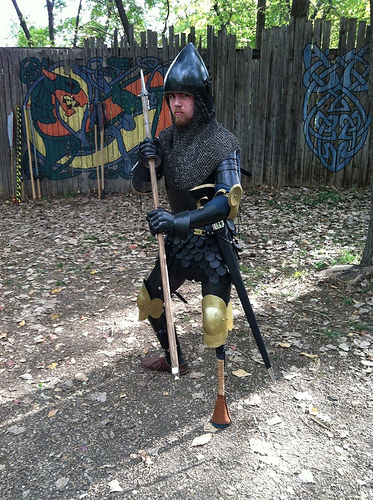
The harness in question
|
|
  |
 |
Jeffrey Hildebrandt
Industry Professional

|
 Posted: Mon 08 Oct, 2012 6:52 pm Post subject: Posted: Mon 08 Oct, 2012 6:52 pm Post subject: |
 |
|
I have not tried every chemical bluing agent on the market, but all those that I have tried invited rather than deterred rust. Heat bluing and blackening both work well, and allow you to keep a bright surface. However, it should be considered that they cannot be re-touched without disassembling the armour, polishing the old surface off, and re-bluing. Here are some instructions for blackening and bluing, which can be accomplished with a minimum of tools:
For blackening (one plate at a time):
-clean the surface
-attach to an armature that will permit even heating
-heat the part to a dull red over a large fire, moving the plate to ensure even heating (keep in mind that heat rises, and that edges heat faster than central areas)
-submerge in oil (be aware that the oil may ignite, but will extinguish shortly)
-remove, wipe off excess oil, then de-grease
For bluing (on plate at a time):
-clean surface
-lay (on a low heat dissipation surface) or suspend flat (because heat rises, so that the top will differ in colour from the bottom if set up-right)
-heat slowly with a propane torch, moving the torch constantly
-when colour becomes a faint yellow note which areas are hotter than others, and apply heat to even out colour
-stop heating when the part is an even blue. If surface is unevenly coloured, it should be polished and re-blued. Quenching is not required.
I hope this helps. There is a blued Vendel helmet and a blackened great helm on my website that give an idea of what surfaces can be acquired with these techniques.
Good luck!
-Hildebrant
Royal Oak Armoury Website
Royal Oak Armoury Facebook
|
|
   |
 |
|
Peter Messent
|
 Posted: Mon 08 Oct, 2012 8:18 pm Post subject: Posted: Mon 08 Oct, 2012 8:18 pm Post subject: |
 |
|
The above methods are all great - the blackening, in particular, gives a great look IMO.
My favorite is a hydrogen peroxide solution. It is a mix of H202, vinegar and salt. I used 35% food grade H202, 4 parts saturated with salt with 1 part vinegar in a spray bottle. Heat the steel (hot tap water is sufficient) to be given a patina and spray on. This quickly foams on the surface and develops a fine surface rust and can be repeated as necessary. I oil that with linseed (wipe on, wipe off) for an aged brown finish (mostly on colonial era items, when it rust-bluing was commonly used on firearms) for a somewhat mottled brown (but very smooth) surface. Alternately, you can then dunk the rusted product in boiling water without oiling and the red rust will turn to blue. As far as I know, boiling a rusted item is the original gun blue, and in my experience is more durable than a chemical blue - but the process is also much more of an art, and can be difficult to get a deep, even blue. My hats off to those who can get it right on large pieces every time! Rustic is much easier to achieve. Ensuring that the steel is degreased is, of course, of huge importance in getting uniformity. Unfortunately my recent attempts at this were with a much lower % hydrogen peroxide, which seemed to yield much less even results, so I won't try it again until I buy some 35%. If you want to attempt this, make sure that you experiment first, as I'm sure it would be a pain to have to strip armor back to bare steel to try again. The moisture and temperature where you do it does make a difference.
|
|
  |
 |
Daniel Wallace

Location: Pennsylvania USA Joined: 07 Aug 2011
Posts: 580
|
 Posted: Tue 09 Oct, 2012 9:11 am Post subject: Posted: Tue 09 Oct, 2012 9:11 am Post subject: |
 |
|
|
i wasn't sure if there was a true 'chemical' bluing agent on the market. most of the bluing agents you can buy are a similar paint or stain for metal. for true chemical bluing as i understand its not recommended by professionals for the dyi person. i'm not positive on what chemicals are used but i know their some pretty nasty acids. and usually the steel is given an bath in the bluing agent that gives off a gas during the reaction. i may be wrong - i haven't attempted it and i wouldn't until i understand more about it.
|
|
  |
 |
|
Christopher Treichel
Location: Metro D.C. Joined: 14 Jan 2010
Posts: 268
|
 Posted: Tue 09 Oct, 2012 10:18 am Post subject: Posted: Tue 09 Oct, 2012 10:18 am Post subject: |
 |
|
On the issue of preventing ruust... you still need to apply some kind of oil constantly. If its anything like my rifles and fussils (flintlocks) I keep a oily rag in my hunting pouch and give it a good rub down a few times a day.
For period correct oild you could use boiled linseed oil, olive oil (old term sweet oil) or other stuff such as mineral oil.
Linseed works the best but has a low cumbustion point so on hot days you have to be careful with the rag.
|
|
  |
 |
Sean Flynt

|
|
   |
 |
Jeffrey Hildebrandt
Industry Professional

|
 Posted: Tue 09 Oct, 2012 3:13 pm Post subject: Posted: Tue 09 Oct, 2012 3:13 pm Post subject: |
 |
|
| Daniel Wallace wrote: | | i wasn't sure if there was a true 'chemical' bluing agent on the market...i'm not positive on what chemicals are used but i know their some pretty nasty acids. |
Jax, Birchwood Cassey and Gunslick all offer chemical solutions that I have tried - I even mixed my own for a while before I realized that real bluing is less work, looks better, prevents rust, costs less and does not harm my health or the environment. You can find MSDS sheets for bluing solutions online - none of them are good for you, and all of them encourage rust because they contain acids like nitric acid, selenious acid and copper sulfate.
Best to avoid them.
-Hildebrandt
Royal Oak Armoury Website
Royal Oak Armoury Facebook
|
|
   |
 |
|
Reece Nelson
|
 Posted: Tue 09 Oct, 2012 5:06 pm Post subject: Posted: Tue 09 Oct, 2012 5:06 pm Post subject: |
 |
|
| Christopher Treichel wrote: | On the issue of preventing ruust... you still need to apply some kind of oil constantly. If its anything like my rifles and fussils (flintlocks) I keep a oily rag in my hunting pouch and give it a good rub down a few times a day.
For period correct oild you could use boiled linseed oil, olive oil (old term sweet oil) or other stuff such as mineral oil.
Linseed works the best but has a low combustion point so on hot days you have to be careful with the rag. |
I oil it every day with gun lubricant, wipe it down with clean rags and it doesn't seem to do the trick :/ I will be making a batch of beeswax with olive oil (Renaissance Wax) soon and will be using that probably from now on.
I spoke with Patrick Thaden about some other options that I might try for bluing it. He suggested I use linseed oil and heat each piece up to 500-525 degrees, but I don't have a furnace :/
 Attachment: 63.64 KB Attachment: 63.64 KB
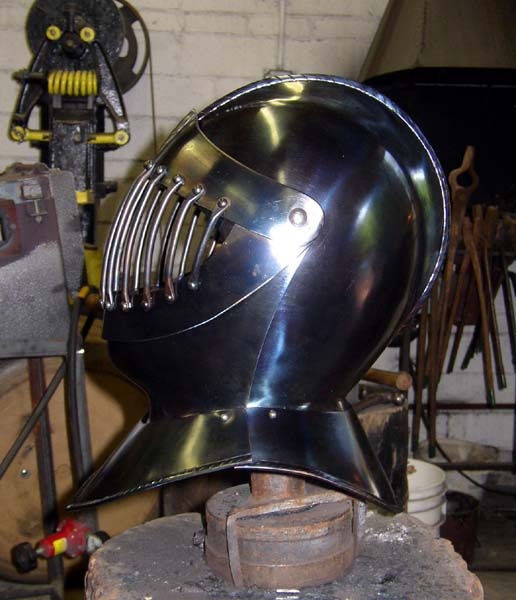
 Attachment: 51.44 KB Attachment: 51.44 KB
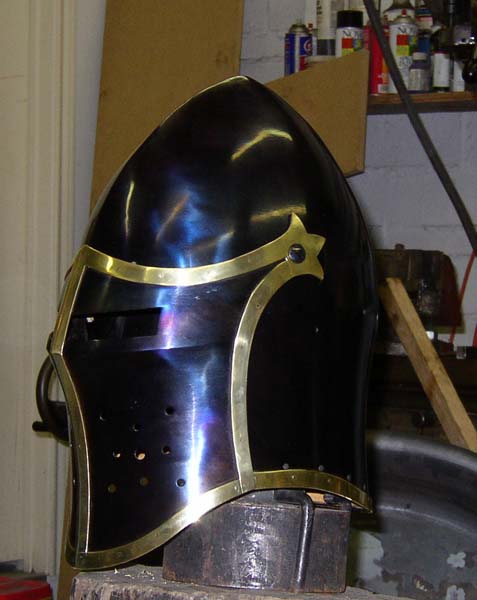
|
|
  |
 |
|
Reece Nelson
|
 Posted: Tue 09 Oct, 2012 5:18 pm Post subject: Posted: Tue 09 Oct, 2012 5:18 pm Post subject: |
 |
|
I could also try gloss black rustoleum paint over rough hammered surface. He suggested that to me to give that "right out of the furnace" look 
It would look neat I think and would be low maintenance compared to getting the linseed oil scratched off, but I might try to achieve that black glossy look that Capwell did on his harness. Thaden said he would ask McPherson his process he used and let me know 
So I'd like to hear peoples opinions on what would look best? The linseed oil, black rustoleum paint or the super sexy shine of the mystery McPherson method? 
 Attachment: 57.96 KB Attachment: 57.96 KB
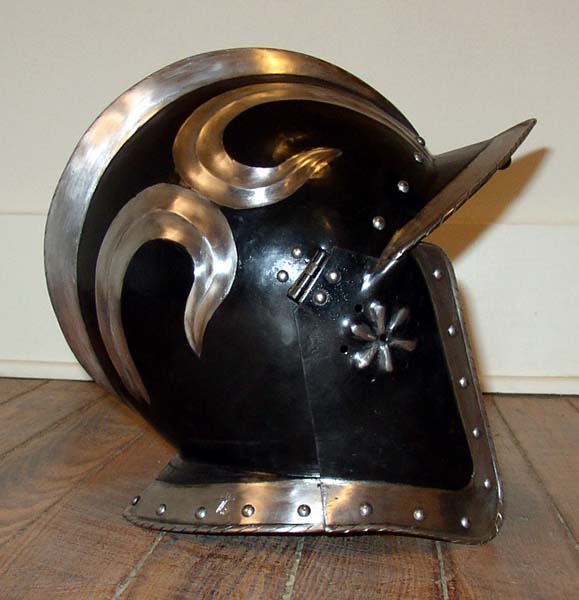
 Attachment: 35.4 KB Attachment: 35.4 KB
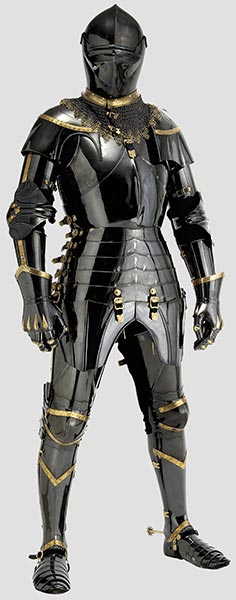
Capwell harness
|
|
  |
 |
|
Jonathon Janusz
|
 Posted: Tue 09 Oct, 2012 6:53 pm Post subject: Posted: Tue 09 Oct, 2012 6:53 pm Post subject: |
 |
|
Reece, the finish Mac put on Toby's old suit (which is now in a private collection and polished bright if I remember correctly) was professionally done. I thought I saw you were also a member at the Armour Archive? I know Mac is a more frequent poster over there, so if a PM here doesn't get him, you might want to try a note over there asking where he got the work done. Mac has always been very helpful to folks looking for advice.
Best of luck and lovely harness! The great helm with the brass looks very nice too!
|
|
  |
 |
|
Rod Walker
Location: NSW, Australia. Joined: 05 Feb 2004
Posts: 230
|
 Posted: Tue 09 Oct, 2012 10:41 pm Post subject: Posted: Tue 09 Oct, 2012 10:41 pm Post subject: |
 |
|
I recently heat blued mine. Gave it a polish, cleaned it and just used a torch hooked up to LPG. Got it more than hot enough. I would have gotten a better finish if I could have heated it more evenly and in one hit. But pretty happy with it.
It is very durable and whilst it is still hot I give it a wipe over with a beeswax/olive oil mix.
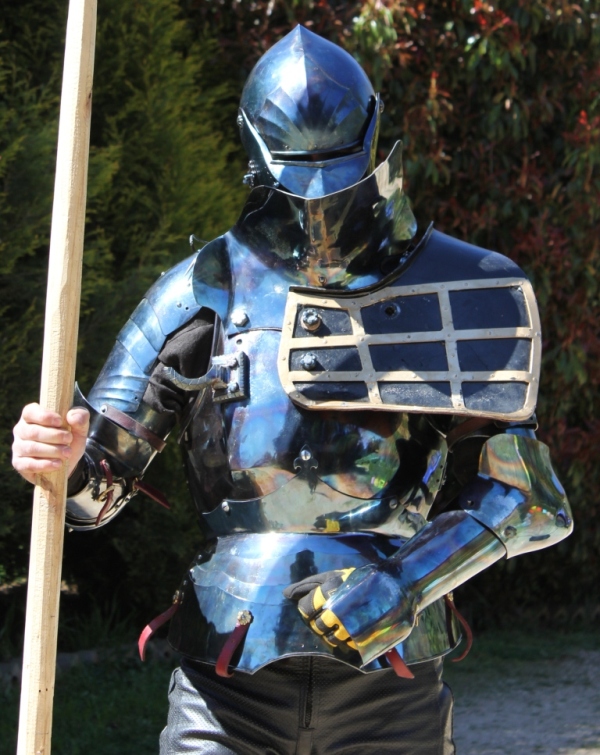
Cheers
Rod
Jouster
www.jousting.com.au
"Come! Let us lay a lance in rest,
And tilt at windmills under a wild sky!
For who would live so petty and unblessed
That dare not tilt at something, ere he die?"
--Errantry, John Galsworthy
|
|
   |
 |
Daniel Wallace

Location: Pennsylvania USA Joined: 07 Aug 2011
Posts: 580
|
 Posted: Wed 10 Oct, 2012 8:27 am Post subject: Posted: Wed 10 Oct, 2012 8:27 am Post subject: |
 |
|
heated bluing to me has its own kind of marbled life to it. especially if you keep the temp down to the low end and bring out the violets. you can kind of choose to what degree of color you want.
i learned how to make steel roses a while back - i made them in heated blue - and what i called marbled blue. i would heat the piece just until it began to change color - backed off the heat and watched the residual heat turn the pettles all kinds of colors, by far my biggest seller a few years ago.
traditional bluing - i also like. but not as much as heated blue
painted - theres a lot of historical records that show painted armour - not just black but also things that stand out. i think this can go as far as the craftsmen's imagination.
|
|
  |
 |
|
Reece Nelson
|
 Posted: Wed 10 Oct, 2012 8:58 am Post subject: Posted: Wed 10 Oct, 2012 8:58 am Post subject: |
 |
|
Heat bluing was what I was originally wanting to do, but I couldn't document it during the early 15th centuries  Its difficult to tell from the historical art if in fact they achieved that color or not. Its difficult to tell from the historical art if in fact they achieved that color or not.
 Attachment: 59.58 KB Attachment: 59.58 KB
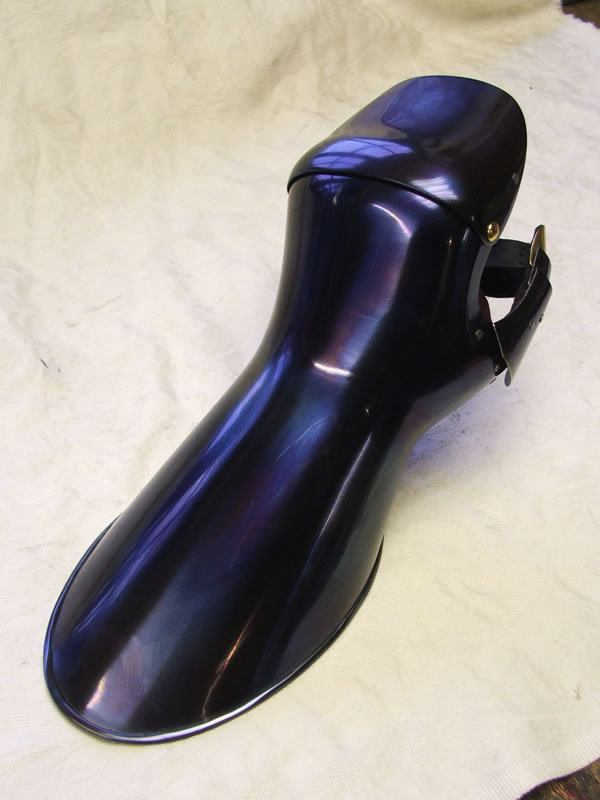
|
|
  |
 |
Sean Flynt

|
|
   |
 |
|
Reece Nelson
|
 Posted: Wed 10 Oct, 2012 1:17 pm Post subject: Posted: Wed 10 Oct, 2012 1:17 pm Post subject: |
 |
|
| Sean Flynt wrote: | | FWIW, the Perma Blue sallet in my avatar has never rusted. It sits on a shelf, so it's not exposed to sweat, etc. but I do handle it pretty often without cleaning it after. I think all I have on that is sewing machine oil. |
Sean, did you heat the helm first before applying the oil? I really like how that came out 
|
|
  |
 |
Sean Flynt

|
 Posted: Wed 10 Oct, 2012 1:53 pm Post subject: Posted: Wed 10 Oct, 2012 1:53 pm Post subject: |
 |
|
No heat. Here's my current process.
• degrease with the most powerful spray engine degreaser you can find (got mine at wal-mart)
• rinse thoroughly
• immerse small pieces in Birchwood-Casey Perma Blue if possible. Otherwise, have the solution ready for application as soon as the rinse is complete. Saturate an applicator (or sponge, for larger pieces) and immediately go over every visible surface. move as fast as possible to cover all exposed surfaces. Otherwise, there will be runs and spotting. Keep saturating the applicator and applying this way until the piece is dark enough. For very large pieces, you might want to experiment with putting the plate in a large darkroom tray or baking pan and just pouring the blue over it so that everything is touched at almost the same instant. With enough solution you could "baste" the piece to keep it covered as the color develops. Don't use that pan for brownies. 
• rinse thoroughly, dry quickly with a paper towell and IMMEDIATELY saturate with light machine oil. I mean, don't even take it from the sink to the workshop. Do it at the sink.
• back at the workbench use 000 or 0000 steel wool to go over the whole piece. this is using almost no pressure at all. just moving the wool around on the surface. this should reduce or eliminate any uneven areas.
• wipe clean with paper towels and re-oil. check it often for a few days, because it seems like steel absorbs that oil like a sponge. You could also use the microcrystaline wax at this point, and that should help. I waxed the blued bastard sword hilt I just made, and that's holding up well in spite of frequent handling.
That usually does it for me. If there are problems with the finish, you can repeat this process locally and still get an even result.
In some light you might see a faint brownish tint, but this is a rusting process, as you well know. That's why the oil is so important once the right color is achieved. I find that if I miss that window by even 30 seconds, it will be too far gone toward bad brown rust.
-Sean
Author of the Little Hammer novel
https://www.amazon.com/Little-Hammer-Sean-Flynt/dp/B08XN7HZ82/ref=sr_1_1?dchild=1&keywords=little+hammer+book&qid=1627482034&sr=8-1
|
|
   |
 |
|
Michael R. Mann
Location: Germany Joined: 26 Jun 2012
Posts: 28
|
 Posted: Wed 10 Oct, 2012 4:18 pm Post subject: Posted: Wed 10 Oct, 2012 4:18 pm Post subject: |
 |
|
As far as I know is that the armours where protected against rust and/or were colored in several ways:
1. By heating of the armour and chilling with linseed oil (simple method) in a fire by coals.
2. By chilling of the heated armour in cold water (blue color).
3. Another method would be the burnishing of the armour in pure acetic acid.
4. Burn-In of colors. (always)
5. The easiest method is: To paint the armour with oil colours.
In wikipedia exists an resp. article: http://de.wikipedia.org/wiki/Plattenpanzer (Kap. Schmieden von Plattenrüstungen)
These tasks where fulffiled by the Plattner (armourers). For burnishing see here: http://de.wikipedia.org/wiki/Br%C3%BCnieren .
If there is an interest I could search around in which times which method was common. Succesfull is perhaps also a search for "bläuen" (bluing) and "brünieren" (burnishing).
But my suggestion is: It's better to let bluing / burnishing the armour by a blacksmith or in a paint shop. Many techniques are dangerous.
BTW.: In the tube exists a clip where a user shows the bluing of metal on a hob in a kitchen.
Chill: I mean the sudden cool down of heated metal.
|
|
  |
 |
J Helmes
Industry Professional

Location: Lanark Highlands Ontario Canada Joined: 06 Mar 2009
Posts: 120
|
 Posted: Fri 12 Oct, 2012 5:19 am Post subject: Posted: Fri 12 Oct, 2012 5:19 am Post subject: |
 |
|
|
Chemical blues, being generally acid based, need to be neutralized prior to oiling. I generally use liberal amounts of ammonia based window cleaner to do this. You may find that this helps. Once the piece is neutralized and clean, conservators wax works well on polished pieces.
|
|
   |
 |
Jeffrey Hildebrandt
Industry Professional

|
 Posted: Fri 12 Oct, 2012 7:30 am Post subject: Posted: Fri 12 Oct, 2012 7:30 am Post subject: |
 |
|
Rinsing and neutralizing sound like good suggestions, and probable explanations for why my chemical bluing has always rusted. I will follow Sean's procedure next time a customer wants an already-lined helmet blued, when removing the lining would be more effort than the actual heating.
Royal Oak Armoury Website
Royal Oak Armoury Facebook
|
|
   |
 |
Sean Flynt

|
 Posted: Fri 12 Oct, 2012 8:04 am Post subject: Posted: Fri 12 Oct, 2012 8:04 am Post subject: |
 |
|
| Jeffrey Hildebrandt wrote: | | Rinsing and neutralizing sound like good suggestions, and probable explanations for why my chemical bluing has always rusted. I will follow Sean's procedure next time a customer wants an already-lined helmet blued, when removing the lining would be more effort than the actual heating. |
I've blued a bevor with the lining in place. A helmet would be much easier, but it's still a good idea to seal/mask the lining. The bluing agent isn't as much a problem as the degreaser. The stench of that stuff is HARD to get out of fabric.
BTW, I really cannot overemphasize the importance of thorough degreasing and careful handling of the degreased piece. I've used this process many times and still do dumb things on occasion. Cross contamination is a potential problem. Have separate materials for each part of the process-degreasing, bluing, oiling/finishing.
Don't be cheap with the disposable gloves. A typical error would involve putting on gloves, HANDLING THE PIECE, degreasing, rinsing and blueing without changing gloves while the piece was in the degreaser. See the problem there? Any oil on the piece before degreasing stayed on the gloves when you handled it after degreasing, and was transferred back to the piece.Treat this process like a complex chicken recipe 
-Sean
Author of the Little Hammer novel
https://www.amazon.com/Little-Hammer-Sean-Flynt/dp/B08XN7HZ82/ref=sr_1_1?dchild=1&keywords=little+hammer+book&qid=1627482034&sr=8-1
|
|
   |
 |
|
|

